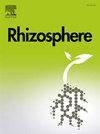Root interactions in wheat/fababean intercropping system enhanced growth performance and yield
IF 3.4
3区 生物学
Q1 PLANT SCIENCES
引用次数: 0
Abstract
Intercropping has been extensively used to facilitate growth performance and yield in agriculture. However, belowground mechanisms that facilitate aboveground growth performance and yield in cereal/legume intercropping have not been sufficiently validated in the context of low molecular weight organic acids (LMWOA) and microbial communities’ interactions. This study utilized Illumina Mi-Sequencing and GC-MS to assess the community structure of microbes and abundance of LMWOA in rhizosphere soil of different partitions of wheat/fababean intercropping systems compared to their sole cropping plots. The results indicate that the aboveground growth performance and yield advantages in freely-interacted (NRP) or semi-interacted (SRP) wheat/fababean intercropping plots are primarily associated with belowground abundance and diversity of beneficial bacterial groups and bioavailability of LMWOA. The relative abundance of some specific PGPR, such as Ellin6067, Candidatus_solibacter, Bryobactor, Gemmatimonas, Anaerolinea and different genera of rhizobium (Allorhizobium and Bradyrhizobium) in NRP and SRP plots are increased significantly at (p < 0.05) as compared to CRP and sole cropping plots. Moreover, LMWOA such as n-hexadecanoic acid, eicosanoic acid-methyl ester (arachidic acid), 9-octadecenoic acid (Z)-methyl ester, and octadecanoic acid were also found to be abundant in NRP plots as compared to their monocropping wheat and fababean. Furthermore, positive correlations of certain dominant LMWOA and PGPR were recorded in the rhizosphere of NRP as compared to monocropping wheat and fababean rhizosphere. Our study indicated that freely or semi-interactions of fababean with wheat restored beneficial microbial community and LMWOA to the rhizospheres, which provided a better understanding of nutrient availability under cereal/legume intercropping practices. Our results implied that fababean-based intercropping may be an efficient cropping system for improving soil fertility and nutrient availability in agricultural practice.

求助全文
约1分钟内获得全文
求助全文
来源期刊

Rhizosphere
Agricultural and Biological Sciences-Agronomy and Crop Science
CiteScore
5.70
自引率
8.10%
发文量
155
审稿时长
29 days
期刊介绍:
Rhizosphere aims to advance the frontier of our understanding of plant-soil interactions. Rhizosphere is a multidisciplinary journal that publishes research on the interactions between plant roots, soil organisms, nutrients, and water. Except carbon fixation by photosynthesis, plants obtain all other elements primarily from soil through roots.
We are beginning to understand how communications at the rhizosphere, with soil organisms and other plant species, affect root exudates and nutrient uptake. This rapidly evolving subject utilizes molecular biology and genomic tools, food web or community structure manipulations, high performance liquid chromatography, isotopic analysis, diverse spectroscopic analytics, tomography and other microscopy, complex statistical and modeling tools.
 求助内容:
求助内容: 应助结果提醒方式:
应助结果提醒方式:


